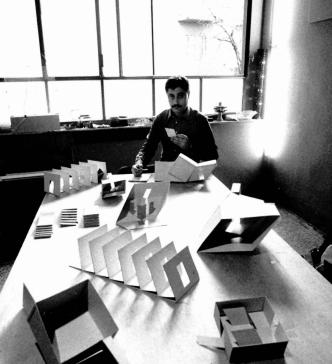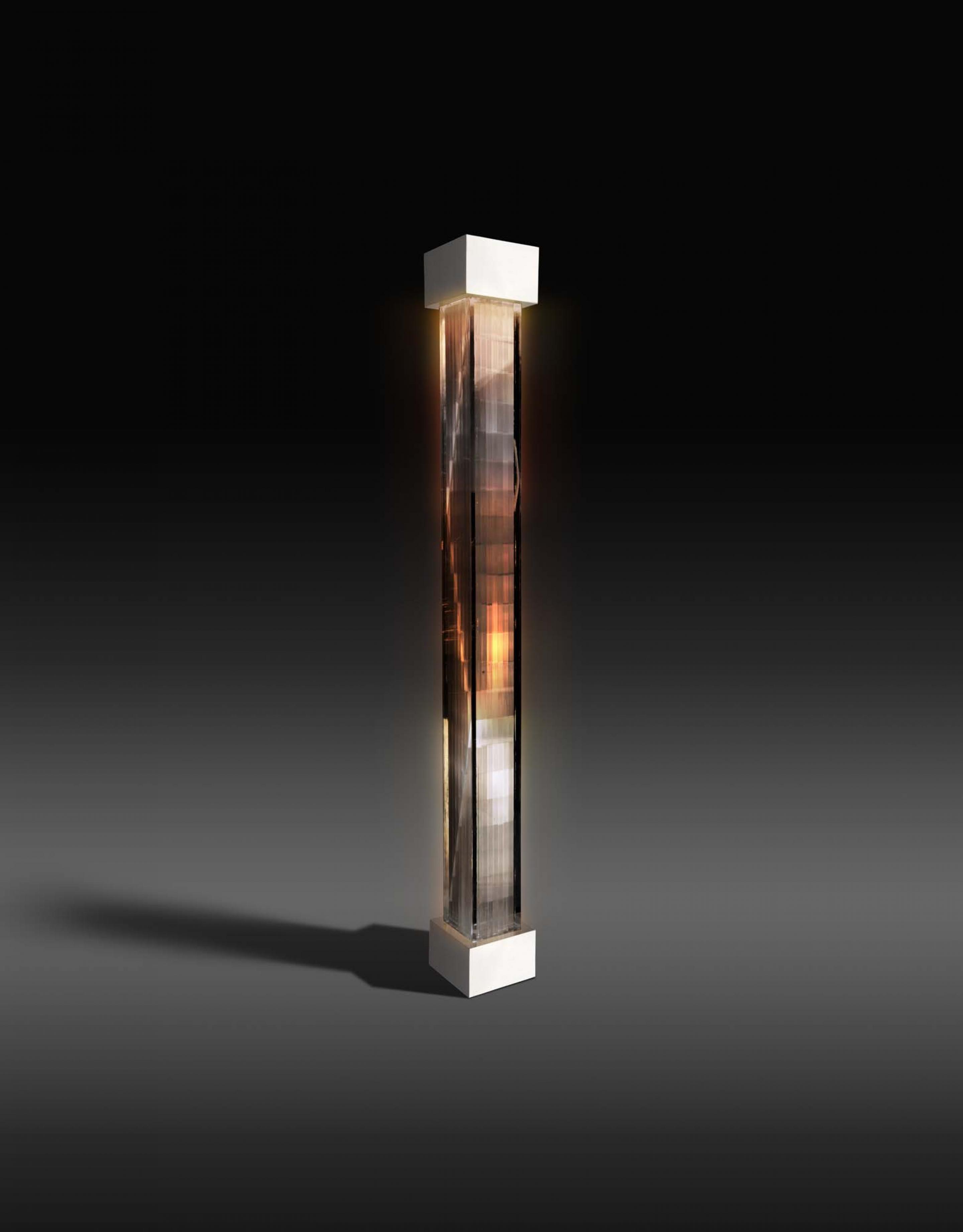GianniCOLOMBO
About
Considered one of the greatest international exponents of kinetic and environmental art, Gianni Colombo made the link between space and body the catalyst for all his three-dimensional investigations.
Using flashes of light, moving objects, immersive environments and isolated architectural elements, the artist created disturbing spatial devices capable of disorienting acquired perceptual forms and deconstructing ordinary behavioural codes.
Gianni Colombo was born in Milan in 1937. After studying at the Brera Academy under the guidance of Achille Funi, in the latter half of the Fifties he created his first kinetic and programmed artworks.
He began exhibiting at Galleria Azimut in 1959, and in October of that year he founded Gruppo T with Giovanni Anceschi, Davide Boriani and Gabriele De Vecchi. Grazia Varisco joined the following year. The group’s aim was to investigate the temporal dimension as an essential factor of an artwork and its reception, and to undertake research into light and perceptual phenomena. In January 1960 Colombo exhibited with Gruppo T at Galleria Pater in Milan; in 1961 at the Nove Tendencije show at Zagreb museum; and in 1962 at the Arte programmata exhibition in Milan, organised by Bruno Munari and Umberto Eco.
In 1963 he took part in the 4th San Marino Art Biennial, and the following year presented his first habitable environment, Strutturazione cinevisuale abitabile at the Nouvelle Tendance exhibition at the Louvre.
In 1965, after appearing in the Zagreb group’s third show, he took part in The Responsive Eye exhibition at the Museum of Modern Art in New York, and his theoretical essay Sulle ricerche plastiche cinevisuali was published in the catalogue.
In 1965 he exhibited in the Nul ‘65 show at the Stedelijk Museum, Amsterdam, and consolidated his relationship with Zero, the artist group based in Düsseldorf.
In 1967 he presented his Spazio elastico environment at the Trigon exhibition in Graz, and together with Gabriele De Vecchi designed Ambiente a strutturazione virtuale for the exhibition Lo spazio dell’immagine held in Foligno, Umbria, in July.
In 1968 he exhibited with Gruppo T in Grenoble but the group separated shortly afterwards. However, Colombo’s work had already been well received for some time, and that same year he won the first prize for painting at the 34th Venice Biennial.
In 1970 he and Vincenzo Agnetti created the Campo practicable environment, which was shown at Studio Marconi. By the late Sixties his research had also turned to video.
In 1971 he presented Total Furnishing Unit at the Museum of Modern Art in New York as part of the exhibition Italy: The New Domestic Landscape.
In 1975 he held a solo show at Studio Marconi, for which he created the Bariestesia environment. He received several public commissions, including a monument to the Resistance for the municipality of Como. In 1980 he took up the chair in Structuring Space at Milan’s Nuova Accademia, and in 1985 became the school’s director.
In 1983 he had an important solo exhibition at the Galleria Civica d’Arte Contemporanea in Suzzara, Lombardy.
The following year he was invited to present his work at the Contemporary Art Pavilion in Milan and at the 39th Venice Biennial, where he was given a solo room.
In 1986 he created the sets for Stephen Climax by M. Zender at the Frankfurt Opera House. Meantime he continued work on the series Architetture cacogoniometriche – Archi, environmental works which he presented in 1992 at the Staatliche Kunsthalle, Baden-Baden.
Gianni Colombo died suddenly in Melzo on 3 February 1993.
In 2010 an important exhibition was dedicated to him at Castello di Rivoli, curated by Carolin Christov-Bakargiev and Marco Scotini.
The most recent major group shows featuring his work were the Thinking Machines exhibition at the MoMA, New York (2018); Vertigo. Op Art and a History of Deception 1520-1970 at the Kunstmuseum, Stuttgart and at the Mumoc in Vienna; and Le diable au corps. Quand l’Op Art électrise le cinéma, at Mamac in Nice (2019).
Using flashes of light, moving objects, immersive environments and isolated architectural elements, the artist created disturbing spatial devices capable of disorienting acquired perceptual forms and deconstructing ordinary behavioural codes.
Gianni Colombo was born in Milan in 1937. After studying at the Brera Academy under the guidance of Achille Funi, in the latter half of the Fifties he created his first kinetic and programmed artworks.
He began exhibiting at Galleria Azimut in 1959, and in October of that year he founded Gruppo T with Giovanni Anceschi, Davide Boriani and Gabriele De Vecchi. Grazia Varisco joined the following year. The group’s aim was to investigate the temporal dimension as an essential factor of an artwork and its reception, and to undertake research into light and perceptual phenomena. In January 1960 Colombo exhibited with Gruppo T at Galleria Pater in Milan; in 1961 at the Nove Tendencije show at Zagreb museum; and in 1962 at the Arte programmata exhibition in Milan, organised by Bruno Munari and Umberto Eco.
In 1963 he took part in the 4th San Marino Art Biennial, and the following year presented his first habitable environment, Strutturazione cinevisuale abitabile at the Nouvelle Tendance exhibition at the Louvre.
In 1965, after appearing in the Zagreb group’s third show, he took part in The Responsive Eye exhibition at the Museum of Modern Art in New York, and his theoretical essay Sulle ricerche plastiche cinevisuali was published in the catalogue.
In 1965 he exhibited in the Nul ‘65 show at the Stedelijk Museum, Amsterdam, and consolidated his relationship with Zero, the artist group based in Düsseldorf.
In 1967 he presented his Spazio elastico environment at the Trigon exhibition in Graz, and together with Gabriele De Vecchi designed Ambiente a strutturazione virtuale for the exhibition Lo spazio dell’immagine held in Foligno, Umbria, in July.
In 1968 he exhibited with Gruppo T in Grenoble but the group separated shortly afterwards. However, Colombo’s work had already been well received for some time, and that same year he won the first prize for painting at the 34th Venice Biennial.
In 1970 he and Vincenzo Agnetti created the Campo practicable environment, which was shown at Studio Marconi. By the late Sixties his research had also turned to video.
In 1971 he presented Total Furnishing Unit at the Museum of Modern Art in New York as part of the exhibition Italy: The New Domestic Landscape.
In 1975 he held a solo show at Studio Marconi, for which he created the Bariestesia environment. He received several public commissions, including a monument to the Resistance for the municipality of Como. In 1980 he took up the chair in Structuring Space at Milan’s Nuova Accademia, and in 1985 became the school’s director.
In 1983 he had an important solo exhibition at the Galleria Civica d’Arte Contemporanea in Suzzara, Lombardy.
The following year he was invited to present his work at the Contemporary Art Pavilion in Milan and at the 39th Venice Biennial, where he was given a solo room.
In 1986 he created the sets for Stephen Climax by M. Zender at the Frankfurt Opera House. Meantime he continued work on the series Architetture cacogoniometriche – Archi, environmental works which he presented in 1992 at the Staatliche Kunsthalle, Baden-Baden.
Gianni Colombo died suddenly in Melzo on 3 February 1993.
In 2010 an important exhibition was dedicated to him at Castello di Rivoli, curated by Carolin Christov-Bakargiev and Marco Scotini.
The most recent major group shows featuring his work were the Thinking Machines exhibition at the MoMA, New York (2018); Vertigo. Op Art and a History of Deception 1520-1970 at the Kunstmuseum, Stuttgart and at the Mumoc in Vienna; and Le diable au corps. Quand l’Op Art électrise le cinéma, at Mamac in Nice (2019).










